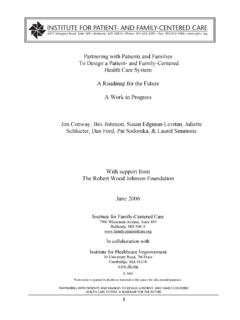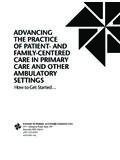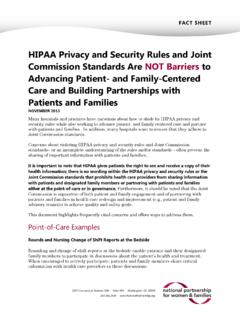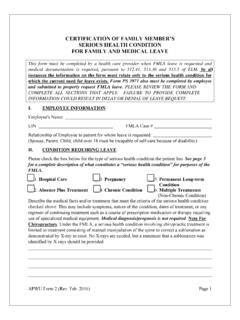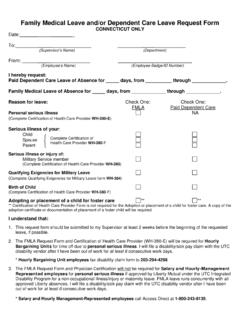Transcription of Family Peer-to-Peer Support Programs in Children’s Mental ...
1 September 2008 Family Peer-to-Peer Support Programs in children s Mental health A Critical Issues Guide National Federation of Families for children s Mental health 9605 Medical Center Drive, Suite 280, Rockville, MD 20850 240-403-1901 or [2] Family Peer-to-Peer Support Programs in children s Mental health : A Critical Issues Guide Table of Contents Acknowledgements .. 3 Introduction and Background .. 3 The Parent Partner Assessment Workgroup .. 4 Purpose of the Guide .. 5 Organization of the 5 Part I: The Backbone: Evaluate Family Peer-to-Peer Support !
2 5 Defining Family .. 5 Defining Family peer .. 6 Defining Types of Support and Developing Outcomes for your Program .. 6 Sample outcomes from the PPAW .. 7 Part II: Then, Design the Program .. 8 Job Descriptions and Job Titles .. 8 Hiring Agency and Location of Family Peer-to-Peer Support Programs .. 8 Samples of hiring agency and location structures from the PPAW .. 9 Training, Supervision and Support .. 9 Sample training and supervision structures from the PPAW .. 10 Ensuring a culturally and linguistically competent program .. 10 The question of certification.
3 10 Sample certification approaches from the PPAW .. 11 Part III: Finally, Seek Funding .. 11 Medicaid .. 12 Sample of funding sources from the PPAW .. 12 Part IV: Summary Conclusion .. 12 Appendix A: The Parent Partner Assessment Workgroup .. 14 History .. 14 Members .. 14 Endnotes .. 15 [3] Acknowledgements Several types of parent Support have emerged as strategies for improving, if not transforming, the children s Mental health care system. They include three in particular. One is the parent partner as used in the context of wraparound teams and as documented in The Resource Guide to Wraparound (NWI, 2008)i.
4 Another is one that sees parents who have systems and life experience as excellent candidates to be paraprofessionals, augmenting the role of clinical health service providers. This second type includes some degree of clinical training and supervision and may be developed, even promoted by professionals and clinicians. The third type is what we are talking about in this resource guide. It is the basic provision of information, Support and advocacy from one parent to another parent going through similar circumstances with their own child. A significant point of clarification that needs to be made here is that the type of parent partner about which this guide is written specifically requires a parent who has a child with serious Mental health needs.
5 (There is more about this criterion on page 5.)These three types of parent partner may overlap in many situations and may even compete in others. We want to express respect for the contributions made to the field by those Programs developing and promoting all variations. This document is the result of numerous collaborative relationships. The National Federation of Families for children s Mental health (National Federation) is indebted to Brigitte Manteuffel of ORC Macro, Inc. and Gary Blau and Sylvia Fisher of the Substance Abuse and Mental health Services Administration (SAMHSA) for seeing the value in convening a group of parent-evaluator teams to expedite their work and to gather lessons learned.
6 These teams, from system of care communities in various stages of developing, implementing and evaluating their own parent-to-parent Support Programs are the Parent Partner Assessment Workgroup (PPAW), convened and facilitated by the National Federation. Their individual and collective commitment, passion, and leadership have moved us one giant step forward and have informed the contents of this guide. We thank the following PPAW members: Eve Bleyhl, Susan Bredice, Maria Delmoro, Beverly Wilkinson, Nor n Dollard, Connie Hammitt, Bill Hobstetter, Teresa King, Gisela Lawson, LuAnn McCormick, Malisa Pearson, Vestena Robbins, Brooke Schewe, Dianne Shaffer, Marya Sosulski, Chris Stormann, Carolyn Sullins, and Amy Winans.
7 The National Federation also would like to thank experts who met with us, advised us, questioned us, and encouraged us. They include Eric Bruns, Al Duchnowski, Barbara Friesen, Kimberly Hoagwood, and Krista Kutash. Finally, we acknowledge our debt to the numerous workshop and listserv participants as well as those individuals who have called the National Federation for technical assistance. Introduction and Background Family Peer-to-Peer Support is the most fundamental element of the children s Mental health Family movement (hereafter referred to simply as the Family movement) and has been for more than 20 years.
8 Families have always intuitively known that sharing information, Support and advocacy with one another is a key to overcoming the challenges of raising and supporting a child with emotional, Mental or behavioral disorders. Family Peer-to-Peer Support , a core function of most Family -run organizations, has been poorly documented, inconsistently funded, and even less well evaluated. The result is that the Family movement is now at a critical crossroads. We know that Family Peer-to-Peer Support is of great value, but current context requires more than intuitive knowing.
9 The National Federation of Families for children s Mental health strongly believes these concerns and questions need to be answered by families in their communities. [4] Current context requires scientific knowledge to claim the value of Peer-to-Peer Support . The concept of evidence-based has emerged as a requirement to fund services and supports in many situations. Thirty years of increasing portions of funding for Mental health services coming from Medicaid, coupled with looming budget deficits are among the most important factors in today s environment.
10 These challenges mandate the children s Mental health Family movement to clearly define and systematically demonstrate the value of Family Peer-to-Peer Support . It must be defined, documented and demonstrated in a language common to funders, policy makers and decision makers. That language that way of knowing is through participatory program evaluation processes. In addition to the above mentioned funding issues, workforce issues such as cultural and linguistic competence and underserved geographical regions have intersected with a changing research agenda to grab the attention of numerous academicians and researchers.
